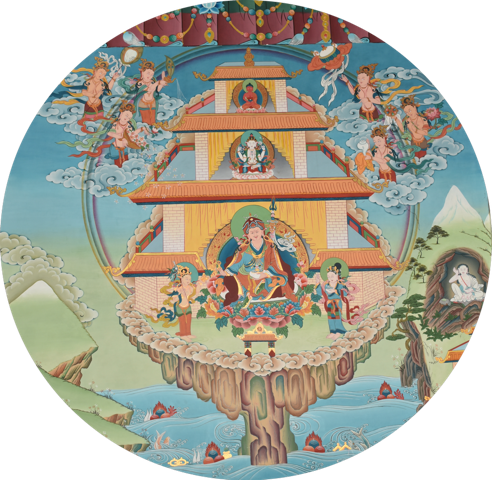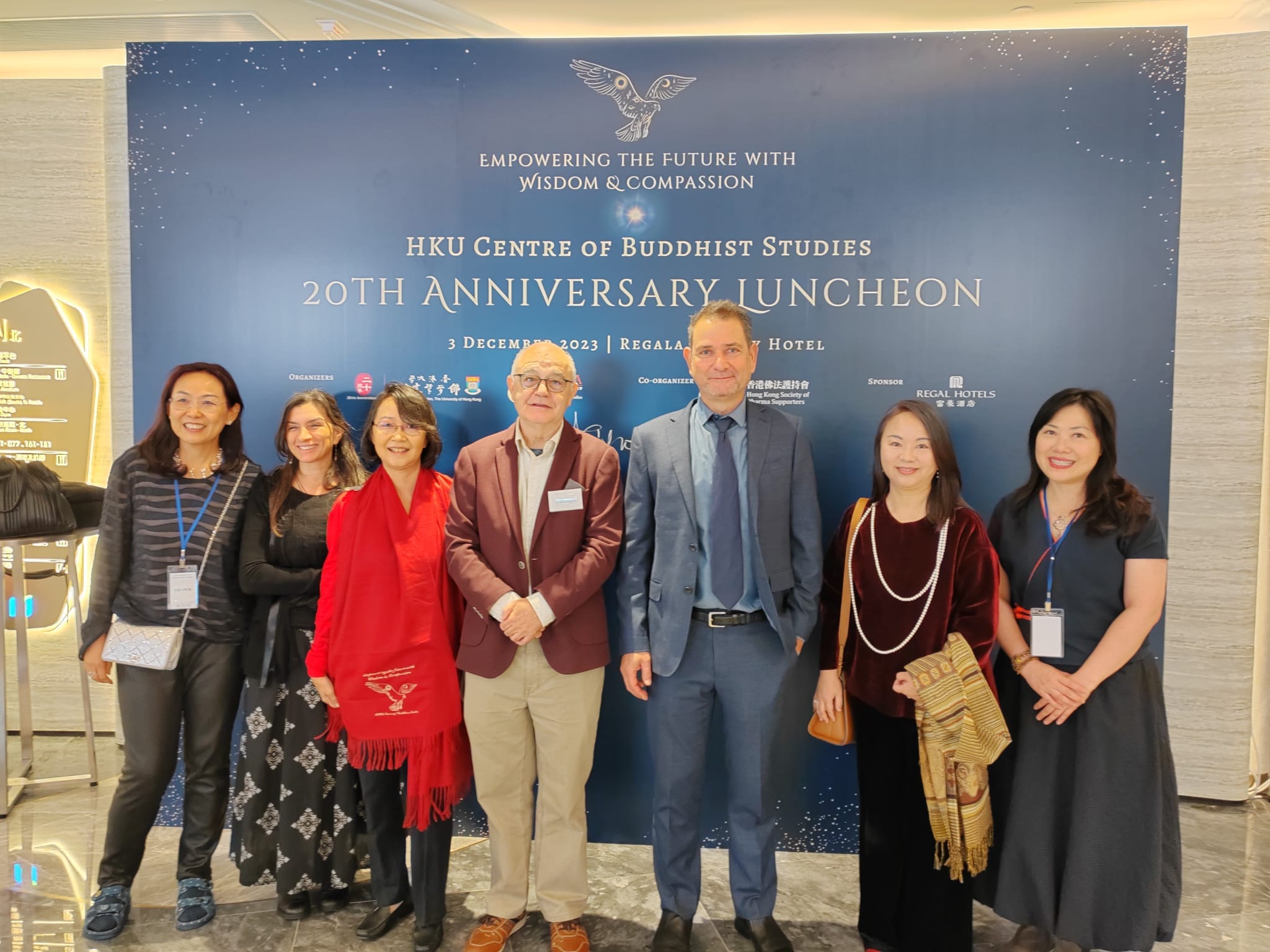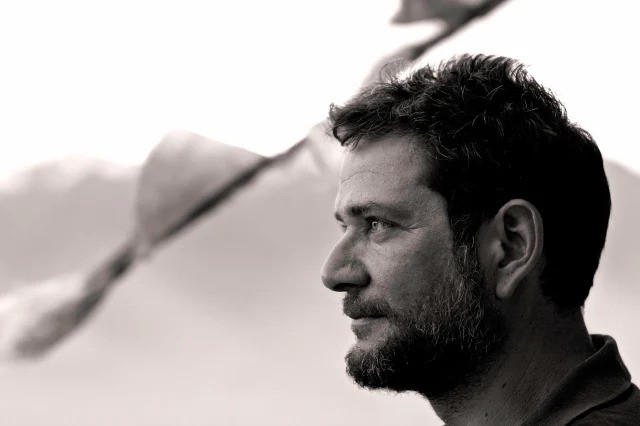2023 has been a very busy year for Dr. Giorgios Halkias. The Centre of Buddhist Studies celebrated its 20th anniversary on 3 December, capping off a period of reorientation since he took over as director from Guang Xing in 2022. Halkias’ academic specialty is in Vajrayana Buddhism, with a focus on the Pure Land tradition in the context of Tibetan history. I am writing a review of The Copper-Colored Mountain: Jigme Lingpa on Rebirth in Padmasambhava’s Pure Land (2022), which was originally an MPhil thesis by Christina Partsalaki (and has been made into a book co-authored between Halkias and Partsalaki). I spoke with Halkias about their research on the Vajrayana tradition’s history of Pure Land thought, as well as the later tradition established by Jigme Lingpa (1729–98) during the second diffusion of Buddhism in medieval Tibet. It was a most welcome throwback to my earliest engagement with Tibetan Buddhist history, as a student of Buddhist Studies more than a decade ago.
The Padmasambhava story is an ancient one that circulated on the Tibetan plateau as early as the collapse of the Tibetan Empire (618–848). It is striking at how long it took for a Pure Land tradition centered on him to emerge from an already copious hagiographical and devotional tradition. “This inquiry, in various respects, has served as a pivotal investigation that inspired our journey into comprehending the widespread appeal of Padmasambhava’s sacred realm. While allusions to Padmasambhava can be found during the era of the Tibetan imperium, as evidenced in certain Dunhuang texts, his hagiographic transformation emerged as a much later phenomenon intricately linked to the tradition of revealed scriptures, known as terma in the 12th century,” said Halkias.
“The earliest records regarding the Copper-Colored Mountain, or Zangdok Palri, do not reveal a clear understanding that Zangdok Palri was a pure land, in the traditional, Indic sense of a buddhakṣetra,” Halkias noted. “Evolving as a vibrant living tradition, the mythos surrounding Padmasambhava transcended ordinary boundaries, assuming a grandeur that rendered him an emblematic figure embodying the manifold facets of the Diamond Vehicle, particularly within the Nyingma School. In many ways our book, The Copper Colored Mountain, serves as a multifaceted gateway to the first and only esoteric pure land to sprout from Tibetan soil, and our humble beginning will hopefully inspire the curiosity of other scholars to delve deeper into the rich heritage of Padma-centric literature in Tibetan Buddhism.”

Early on in his book, Halkias outlines how Padmasambhava and Zangdok Palri were seen by adepts as representations of the path of awakening and realization. “Indeed, the interpretation of Padmasambhava and Zangdok Palri as symbolic embodiments of the path of awakening and realization holds significance for Buddhist practitioners. It is worth exploring potential philosophical and ideological connections between this metaphorical-archetypal understanding espoused in Jigme Lingpa’s The Secret Path, and non-literalist notions concerning Zen and Pure Land teachings, particularly the concept of rebirth within the present lifetime,” he noted.
While philosophical and ideological connections may vary among different Buddhist traditions and schools, there are conceptual intersections. “In both Zen and Pure Land traditions, there exists a recognition of the transformative potential inherent in the present moment and the possibility of attaining liberation and enlightenment within this very existence. In Zen, the emphasis lies on direct experiential realization through meditation. Zen encourages practitioners to awaken to the inherent Buddha-nature within themselves and to realize the nature of reality directly, unmediated by conceptual constructs. This approach aligns with the idea that rebirth can manifest through a profound shift in perception and understanding, leading to a transformative awakening within one’s present life,” said Halkias.
Pure Land teachings, on the other hand, emphasize the aspiration to be reborn in a buddha-field, specifically, Sukhavati or the western paradise. “While this may be seen as a future-oriented aspiration,” noted Halkias, “the Pure Land can also be seen as a metaphorical representation of a purified state of mind or consciousness that can be realized in the present. Awakening in this lifetime could be understood as the cultivation of qualities such as faith, devotion, and the embodiment of wisdom and compassion, leading to a profound transformation and realization of oneself and one’s surroundings to be free of defilements and therefore pure.” The metaphorical-archetypal interpretations in The Secret Path can therefore find resonance with non-literalist orientations in Zen and Pure Land teachings.

Since the past few centuries, contemporary Vajrayana masters have engaged in the construction of temples resembling Padmasambhava’s Pure Land, while expounding teachings that facilitate the realization of the Copper Colored Mountain. “There are some Tibetan studies that address the topic of Zangdok Palri. However, scholarly investigations conducted in English, specifically exploring the practices and proponents of this particular tradition among contemporary Buddhist master practitioners, are conspicuously scarce,” Halkias told me.
Some notable exceptions include Halkias’ own book, The Great Tertön: the Life and Activities of Chokhyur Lingpa (2016), along with Suawan Pui Lamsam’s and Kesang Choden Tashi’s contribution Zangdok Palri: The Lotus Light Palace of Guru Rinpoche (2012). Halkias observes that present anthropological and ethnographic research lacks comprehensive studies that critically examine present-day rituals, customs, and the extent of devotees involved in ritual and contemplative practices associated with Padmasambhava’s Pure Land.
“In comparison to other Tibetan aspiration prayers dedicated to the Copper Colored Mountain, Jigme Lingpa’s work, The Secret Path, exhibits a distinctiveness that sets it apart,” said Halkias. “Notably, it encompasses a comprehensive outline of various Vajrayana practices, ultimately culminating in the teachings of the Great Perfection. This stands in contrast to the conventional exoteric Mahayana Pure Land aspiration prayers. Within the realm of Buddhist literature, it is uncommon for esteemed masters to openly extol their own works; however, all of Jigme Lingpa’s teachings are exceptional in their own right.”

Halkias concluded with an observation of the uniqueness of Jigme Lingpa’s composition amidst the many aspiration prayers devoted to Zangdok Palri. “This distinction can be attributed to two pivotal factors. Firstly, Jigme Lingpa’s work is categorized as a revealed text, intricately woven into the fabric of the renowned Nyingthig tradition, also known as the Seminal Heart tradition. Secondly, it presents a meticulous and panoramic exposition of the ninefold path to enlightenment according to the Nyingma tradition, with a particular emphasis on the profound non-dual teachings of the Great Perfection.”
The impact of Jigme Lingpa’s seminal work has been further amplified by Khangsar Tenpe Wangchuk’s scholarly treatment. He was a prominent Tibetan scholar of the 20th century and his commentary, The Jewelled Staircase to Liberation: A Concise Commentary to the Glorious Copper-Colored Mountain Jewelled Staircase, serves as an illuminating companion to Jigme Lingpa’s masterpiece. “It has served to generate interest and exploration among scholars and practitioners alike,” said Halkias, and no doubt the work partially inspired his own careful reflection and study of The Secret Path. There are doubtless many other works that are of importance in the Vajrayana heritage, yet remain understudied.
The motto of CBS, perhaps reflecting Halkias’ own academic background and a preference for the sober and steady, is now: “Empowering the future with wisdom and compassion.” A carefully worded slogan, it indicates Halkias’ priority and approach: a return to the rigorous basics of Buddhist Studies, which is aligned with the two wings of prajna and karuna, while looking to empower students, faculty, and all involved with the Centre with an eye to the future.
Related blog posts from BDG
Celebrating Two Decades of Buddhist Studies Excellence in Hong Kong


